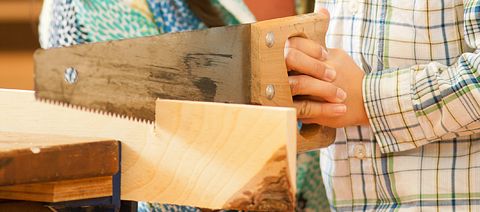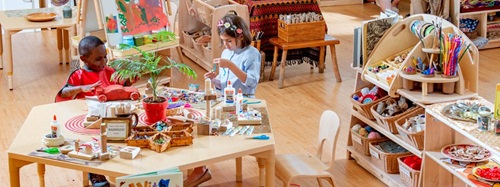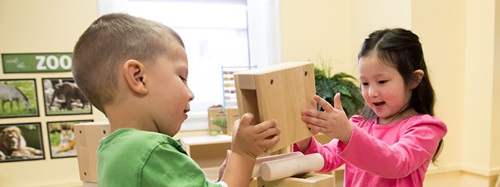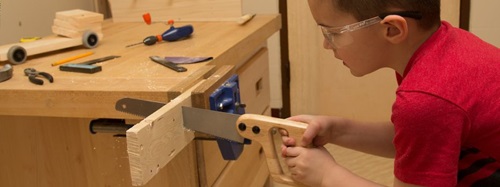The Power of the Woodworking Bench
| February 2015“Clunk, clunk, zzzz-zzzzz—thunk!”
These are sounds of kids using tools at a woodworking bench. Sounds once familiar and pleasurable to me during my teaching days. I no longer hear those sounds during my visits to schools, nor do I see woodworking benches as part of the classroom environments. When I talk to teachers about the importance and value of woodworking for young children, they are astonished and incredulous that I would even suggest that young children use real tools such as hammers and saws. They often laugh at such an idea and say, “Do you know what little children are like?”
Oh, but I do know what little children are like.
In the school where I taught for 25 years, every classroom had a beautiful woodworking bench inhabiting a special space in the room. Along the back of the bench, carefully arranged on pegboard within easy reach, hung the tools needed to experience the satisfaction of building, constructing, and creating with wood. The children used real saws, hammers, hand drills, nails, screwdrivers, sand paper and pliers. They became adept at using the vise, winding it backward to open it and forward to close it. They understood the importance of safety and always wore their goggles.
In our school, every classroom, from the three-year-old room through first grade, was equipped with one woodworking bench, along with a vise, safety goggles, two hammers, nails, wood, and a saw. This was the basic equipment. Both boys and girls used the woodworking bench with equal fervor. In 35 years, except for an occasional sore thumb due to a slip of the hammer, we never had a serious accident.
Three-year-old children spent most of their time hammering. Sometimes we gave them short tree stump discs to hammer and they would pound away. They also learned how to remove the nails by using the claw of the hammer and that alone seemed to be an interesting challenge for them. Their hand-eye coordination improved and developed. They exuded confidence and I imagine they were thinking, “I am hammering! I am a woodworker!”
Older children used the hand drill and screwdrivers, along with the basic tools. They eventually built things—boats, birdhouses, and all kinds of constructions. Some children painted their constructions or used glue to adorn them with buttons, twigs, paper or whatever they found in our collage bins. Other children built part of a construction one day and then continued into the next, thinking in between about what they wanted to do. Kindergarten and 1st grade children often sketched their designs on paper before starting the actual woodworking.
The children became adept at using the tools. They learned how to stand when sawing a piece of wood so that their balance and strength aided in the most efficient cut, usually left foot forward, right back if right-handed and vice versa for left- handed children.
The smell and feel of wood, the clunk-clunk-clunk of the hammer, the zzz-zzz-zzz sound of the saw, the use of their muscles, the rhythmic movement of their bodies—all of these combined to make an experience for children which other kinds of play could not. Children gained a sense of power and competence while learning about tools and the physical properties of materials. Nothing could beat the look on a child’s face, after spending a long time and hard work on sawing through a piece of wood, when it finally landed on the floor with a “thunk.” It was a look of wide-eyed astonishment and pride, as if to say, “I made this happen!”
Kids today and behavior challenges
Occasionally teachers complain that children today are more troublesome than in the past and their difficult behavior prohibits schools from providing this sort of equipment. They deem it dangerous and too risky. I have been in many schools. Children are no different now than they used to be. Unruly behavior is often due to a lack of active, interesting play or an overemphasis on academics and under-emphasis on intellectually challenging experiences. There have always been children more difficult than others. I’ve been kicked, spat upon, yelled at, and I had to deal with tantrums colossal. This is all part of working with young children who are rapidly developing. But you know what? Those same children used the woodworking bench. They handled hammers and saws with no incidents. In fact, it provided a way for them to feel strong and competent without being aggressive toward others. When two children worked at the woodworking bench, they were completely immersed in their work. They concentrated on having the hammer meet the nail, the saw continuing its rhythmic path. They were much too busy and engaged to even notice each other. Besides, when children feel competent and happy, they rarely bicker or argue with each other.
Woodworking benefits:
It is easy to list the benefits from woodworking for children. Here are a few:
- Emotional/Social: Sense of competence, confidence, responsibility, respect for self and others, respect for materials and safety
- Physical: Eye-hand coordination, strength, and fine-motor control
- Cognitive/Intellectual: Mathematical thinking (size, shape, volume, measurement, directionality, geometry), engineering skills, creativity, and inventiveness
- Aesthetics: The smell and feel of wood, the dusty friction of sanding something smooth, the contrast of warm wood and cold metal
Cost:
The initial investment in providing a workbench and tools can be costly but you will have them for a very long time. Instead of ruling them out because of cost, eliminate other nonessentials and provide the highest quality materials that benefit children the most.
- Good quality woodworking benches and tools are expensive but, since they are designed to be hammered and nicked, they last forever.
- Wood can be difficult to find. Try to work out an arrangement with a builder or contractor who can provide you with “leftover” wood pieces. Also consider using low tree stumps.
A natural for STEM activities
With the emphasis on STEM (science, technology, engineering, mathematics) in early childhood classrooms, the workbench provides preschool and primary school children a means to become makers, tinkerers and engineers. If we are serious about helping children master science concepts, then we need to provide children with real experiences, not artificial substitutes. If we want children to be confident about pursuing interests in STEM, then we need to give them materials that are open ended to foster the use of their imaginations and creativity. If we respect children’s modes and ways of learning and thinking, then we need to give them opportunities to experience meaning and joy in the work and play that they do.
As children become more skillful at using tools, they solve problems, become flexible in their thinking and doing and confident about their abilities. The woodworking bench provides the potential to help children develop important skills in science, engineering, and mathematics and gain a sense of power, satisfaction and accomplishment so that they can shout, “I made this happen!”






